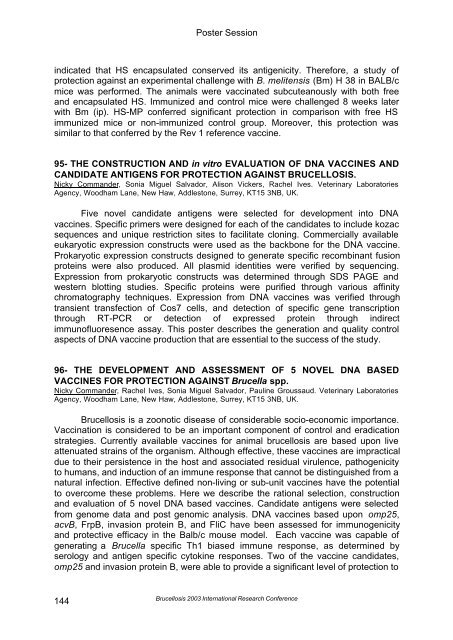Brucellosis 2003 proceedings - PHIDIAS
Brucellosis 2003 proceedings - PHIDIAS
Brucellosis 2003 proceedings - PHIDIAS
You also want an ePaper? Increase the reach of your titles
YUMPU automatically turns print PDFs into web optimized ePapers that Google loves.
Poster Session<br />
indicated that HS encapsulated conserved its antigenicity. Therefore, a study of<br />
protection against an experimental challenge with B. melitensis (Bm) H 38 in BALB/c<br />
mice was performed. The animals were vaccinated subcuteanously with both free<br />
and encapsulated HS. Immunized and control mice were challenged 8 weeks later<br />
with Bm (ip). HS-MP conferred significant protection in comparison with free HS<br />
immunized mice or non-immunized control group. Moreover, this protection was<br />
similar to that conferred by the Rev 1 reference vaccine.<br />
95- THE CONSTRUCTION AND in vitro EVALUATION OF DNA VACCINES AND<br />
CANDIDATE ANTIGENS FOR PROTECTION AGAINST BRUCELLOSIS.<br />
Nicky Commander, Sonia Miguel Salvador, Alison Vickers, Rachel Ives. Veterinary Laboratories<br />
Agency, Woodham Lane, New Haw, Addlestone, Surrey, KT15 3NB, UK.<br />
Five novel candidate antigens were selected for development into DNA<br />
vaccines. Specific primers were designed for each of the candidates to include kozac<br />
sequences and unique restriction sites to facilitate cloning. Commercially available<br />
eukaryotic expression constructs were used as the backbone for the DNA vaccine.<br />
Prokaryotic expression constructs designed to generate specific recombinant fusion<br />
proteins were also produced. All plasmid identities were verified by sequencing.<br />
Expression from prokaryotic constructs was determined through SDS PAGE and<br />
western blotting studies. Specific proteins were purified through various affinity<br />
chromatography techniques. Expression from DNA vaccines was verified through<br />
transient transfection of Cos7 cells, and detection of specific gene transcription<br />
through RT-PCR or detection of expressed protein through indirect<br />
immunofluoresence assay. This poster describes the generation and quality control<br />
aspects of DNA vaccine production that are essential to the success of the study.<br />
96- THE DEVELOPMENT AND ASSESSMENT OF 5 NOVEL DNA BASED<br />
VACCINES FOR PROTECTION AGAINST Brucella spp.<br />
Nicky Commander, Rachel Ives, Sonia Miguel Salvador, Pauline Groussaud. Veterinary Laboratories<br />
Agency, Woodham Lane, New Haw, Addlestone, Surrey, KT15 3NB, UK.<br />
<strong>Brucellosis</strong> is a zoonotic disease of considerable socio-economic importance.<br />
Vaccination is considered to be an important component of control and eradication<br />
strategies. Currently available vaccines for animal brucellosis are based upon live<br />
attenuated strains of the organism. Although effective, these vaccines are impractical<br />
due to their persistence in the host and associated residual virulence, pathogenicity<br />
to humans, and induction of an immune response that cannot be distinguished from a<br />
natural infection. Effective defined non-living or sub-unit vaccines have the potential<br />
to overcome these problems. Here we describe the rational selection, construction<br />
and evaluation of 5 novel DNA based vaccines. Candidate antigens were selected<br />
from genome data and post genomic analysis. DNA vaccines based upon omp25,<br />
acvB, FrpB, invasion protein B, and FliC have been assessed for immunogenicity<br />
and protective efficacy in the Balb/c mouse model. Each vaccine was capable of<br />
generating a Brucella specific Th1 biased immune response, as determined by<br />
serology and antigen specific cytokine responses. Two of the vaccine candidates,<br />
omp25 and invasion protein B, were able to provide a significant level of protection to<br />
144<br />
<strong>Brucellosis</strong> <strong>2003</strong> International Research Conference
















